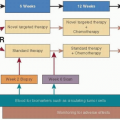of the most potent of these murine monoclonal antibodies were subsequently fused into a human IgG1 framework, resulting in a humanized HER2-directed monoclonal antibody, trastuzumab (13). Preclinical studies of trastuzumab demonstrated that following the humanization procedure, the activity of the antibody against HER2-overexpressing cancer cell lines and xenografts was retained, particularly when used in combination with other cytotoxic therapeutics (14). Numerous studies have been conducted that focused on the mechanisms of trastuzumab-related anti-tumor activity. Several plausible hypotheses have been suggested to account for the clinical activity of trastuzumab. Resolution of the crystal structure of trastuzumab complexed with HER2 has led to identification of a trastuzumab-binding epitope in the juxtamembrane region (subdomain IV) of the HER2 ectodomain. It is possible that this juxtamembrane binding generates steric alteration of HER2 dimers to the extent that intracellular tyrosine kinase domains cannot efficiently interact and activate (8). Moreover, modification of key cell cycle regulators (i.e., increased levels of p27, a Cdk2 inhibitor) subsequent to trastuzumab binding have been observed (15). Studies additionally suggest that inhibition of HER2 ectodomain cleavage by metalloproteinases may serve as a mechanism of trastuzumab activity, because the truncated p95 fragment generated from cleavage retains intracellular kinase activity (16, 17). Alternatively, preclinical data support stimulation of antibody-dependent cellular cytotoxicity (ADCC) as an important mediator of trastuzumab’s mechanism(s) of action (18, 19).
TABLE 72-1 Key Trials of Trastuzumab Therapy and Associated Response Rates | |||||||||||||||||||||||||||||||||||||||||||||||||||||||||||||||||||||||||||||||||||||||||||||||||||||||||||||||||||||||||||||||||||||||||||||||||||||||||||||||||||||||||||||||||||||||||||||||||||||||||||||||||||||||||||||||||||||||||||||||||||||||||||||||||||||||||||||||||||||||||||||||||||||||||||||||||||||||||||||||||||||||||||||||||||||||||||||||||||||||||||||||||||||||||||||||||||||||||||||||||||||||||||||||||||||||||||||||||||||||||
|---|---|---|---|---|---|---|---|---|---|---|---|---|---|---|---|---|---|---|---|---|---|---|---|---|---|---|---|---|---|---|---|---|---|---|---|---|---|---|---|---|---|---|---|---|---|---|---|---|---|---|---|---|---|---|---|---|---|---|---|---|---|---|---|---|---|---|---|---|---|---|---|---|---|---|---|---|---|---|---|---|---|---|---|---|---|---|---|---|---|---|---|---|---|---|---|---|---|---|---|---|---|---|---|---|---|---|---|---|---|---|---|---|---|---|---|---|---|---|---|---|---|---|---|---|---|---|---|---|---|---|---|---|---|---|---|---|---|---|---|---|---|---|---|---|---|---|---|---|---|---|---|---|---|---|---|---|---|---|---|---|---|---|---|---|---|---|---|---|---|---|---|---|---|---|---|---|---|---|---|---|---|---|---|---|---|---|---|---|---|---|---|---|---|---|---|---|---|---|---|---|---|---|---|---|---|---|---|---|---|---|---|---|---|---|---|---|---|---|---|---|---|---|---|---|---|---|---|---|---|---|---|---|---|---|---|---|---|---|---|---|---|---|---|---|---|---|---|---|---|---|---|---|---|---|---|---|---|---|---|---|---|---|---|---|---|---|---|---|---|---|---|---|---|---|---|---|---|---|---|---|---|---|---|---|---|---|---|---|---|---|---|---|---|---|---|---|---|---|---|---|---|---|---|---|---|---|---|---|---|---|---|---|---|---|---|---|---|---|---|---|---|---|---|---|---|---|---|---|---|---|---|---|---|---|---|---|---|---|---|---|---|---|---|---|---|---|---|---|---|---|---|---|---|---|---|---|---|---|---|---|---|---|---|---|---|---|---|---|---|---|---|---|---|---|---|---|---|---|---|---|---|---|---|---|---|---|---|---|---|---|---|---|---|---|---|---|---|---|---|---|---|---|---|---|---|---|---|---|---|---|---|---|---|---|---|---|---|---|---|---|---|---|---|---|---|---|---|---|---|---|---|---|---|---|---|---|---|---|---|---|---|
| |||||||||||||||||||||||||||||||||||||||||||||||||||||||||||||||||||||||||||||||||||||||||||||||||||||||||||||||||||||||||||||||||||||||||||||||||||||||||||||||||||||||||||||||||||||||||||||||||||||||||||||||||||||||||||||||||||||||||||||||||||||||||||||||||||||||||||||||||||||||||||||||||||||||||||||||||||||||||||||||||||||||||||||||||||||||||||||||||||||||||||||||||||||||||||||||||||||||||||||||||||||||||||||||||||||||||||||||||||||||||
trastuzumab. A much lower rate of cardiac dysfunction was observed in the remaining groups, with an incidence of 8%, 13%, and 1% in groups that had received anthracycline and cyclophosphamide alone, paclitaxel and trastuzumab, and paclitaxel alone, respectively. Grade III or IV New York Heart Association (NYHA) cardiac dysfunction was similarly observed at a much higher frequency in the group that received combined anthracycline and trastuzumab therapy. Increasing age was noted to be a risk factor associated with cardiac dysfunction within this subgroup. Notably, cumulative anthracycline dose did not correlate with cardiac toxicity; however, the vast majority of patients in this treatment arm received the prescribed six doses of anthracycline treatment (4). Results from this trial led to caution in formulating further trials of trastuzumab therapy with concomitant anthracycline. The optimal schedule for regular cardiac follow-up has yet to determined in the metastatic setting of the treatment of HER2-positive breast cancer. Additional methods of assessing cardiac function both in terms of modality and introduction of newer methods such as biomarkers may play a role in the future of cardiac testing.
Stay updated, free articles. Join our Telegram channel

Full access? Get Clinical Tree







